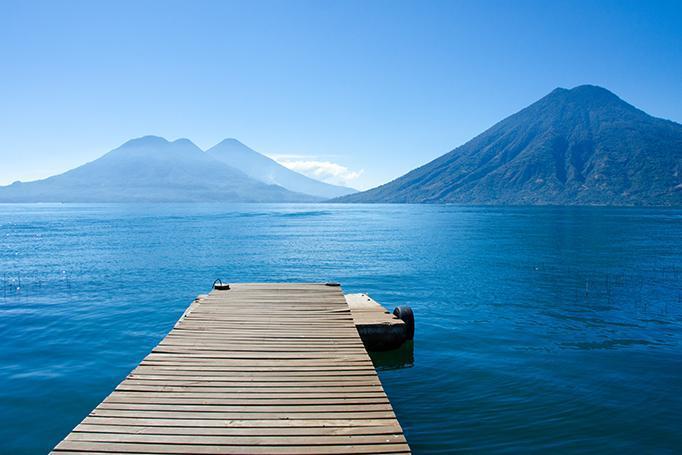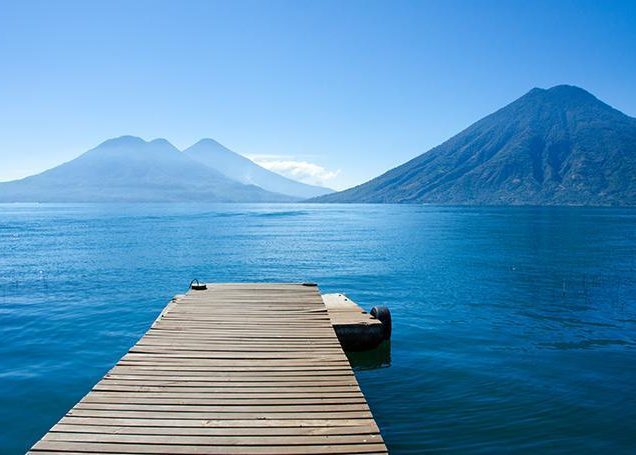

A Honduras adventure tour will show you all this wonderful country has to offer the traveller. From the charming town of Copán Ruinas, the Mayan ruins of Copán are within walking distance and is one of the best-kept and most intriguing of all the ancient Maya sites. See the intricately carved stelaes (carvings/statues) depicting the 16 rulers of this once magnificent and influential city, the spectacular staircase, ball courts and enormous main plaza.
Our Honduras adventure tours travel to La Ceiba where we go by ferry across to Roatán, the largest of the beautiful sun-soaked Caribbean Bay Islands. Development on the island means there is plenty to do, but it is also easy to find a deserted beach lapped by warm Caribbean waters. Here you will find palm-fringed lagoons, turquoise water, friendly locals, lively nightlife and stunning underwater scenery, with some of the cheapest diving and snorkelling in the world! Travelling south through the country, enjoy the scenery and lush countryside as we travel by local buses through this fascinating region on your Honduras adventure tour.

During the first millennium, Honduras was inhabited by the Maya. Columbus explored the country in 1502. Honduras, with four other Central American nations, declared its independence from Spain in 1821 to form a federation of Central American states. In 1838, Honduras left the federation and became independent. Present-day Honduras is a safe and welcoming country, a democracy headed by popularly elected president, Ricardo Maduro.
The climate is split between the central highlands (where Tegucigalpa is located), where the weather is temperate all year round (and cool in the evenings), and the coasts and flatlands, where it is usually hot and humid. There is a rainy season throughout Central America, which starts around May/June and gradually works its way through until September and even sometimes October/November. Don’t be put off by the term rainy season, as this generally only means sporadic downpours a couple of times a day. Of course, there are times, when this is not the case but it is fairly rare for continual rain to persist. The temperatures in Honduras are similar to other northern hemisphere countries, where it’s warmer in summer (July/August) and cooler in winter (December/January). Generally, the hottest time in Honduras will be the months of April to May.
For divers – water visibility is best from March to September, but is still considered good most times of year.
The hurricane season on the Caribbean side of Central America runs from September to November. Usually this only means high winds and occasional storms. It is highly unlikely that the full force of a hurricane would hit any of the areas we pass through on our tours, however our tour leaders are fully prepared to take any necessary action and would make itinerary changes if required to ensure the safety of clients.
Visit www.worldclimate.com to get an idea of what the weather will be like on your tour.
Most nationals do not need a visa to enter Honduras, but it is important to check the rules for your nationality with your nearest embassy or consulate. As a tourist you are usually entitled to 30 days, however depending on the immigration official you can be allocated less days.
On entering you may be asked to fill out an immigration card. A copy of this card should stay in your passport until you exit the country.
There is no official fee to enter Honduras, but you can be charged an unofficial fee. It is the same to exit the country. Please note: If you are travelling by coach across borders, your tour leader will collect your border tax money in advance. This will cost a little more than you’d pay crossing individually, but it’s worth paying the extra to have a hassle-free and speedy border crossing)
The monetary unit in Honduras is the lempira (named after a famous indigenous chief who died fighting the Spaniards). For up-to-date exchange rates with your own currency visit www.oanda.com or www.xe.com.
US dollars are accepted for some purchases in Honduras, however you will need lempiras for most purchases. Even if you have the choice of paying for things in dollars it will be in your interest to use local currency. Having said that, often if you pay for something in dollars you get your change in lempiras at a good rate, which may save you the hassle of having to exchange your money.
US dollars and travellers cheques can be changed at; banks, border crossings and some hotels/shops/agencies. Your tour leader will give you details of when and where best to change money. You will find that banks give the best rates for changing cash and travellers cheques, but it may be more convenient for you to change at the border or in hotels/agencies. Copan Ruinas is the most convenient place for you to exchange enough for all your time in Honduras. In the other places it may be either inconvenient or simply not possible.
Often the easiest way to obtain local currency is to use the ATMs (‘cajeros automaticos’) located in most of the places we travel to. Visa, Plus, MasterCard and Cirrus/Maestro are accepted in most Honduran ATMs. ATMs will only give you local currency.
Note: In Honduras ATM machines are often ‘out of order’. Do not rely on your card as your only source of money. Always have a few back-ups with you.
Credit cards are accepted in some shops/restaurants/hotels. The most accepted credit card is Visa, although authorisation can sometimes be denied due to poor computer connections or other problems! Note there may sometimes be commission charged when paying by credit card (up to 8%).
In Honduras you will not usually be able to use US dollar notes which are torn or marked even slightly. If your notes are at all damaged you may use them in Belize.
Remember that once out of Honduras you will generally not be able to use or exchange lempiras (except at the border towns). Therefore you must make sure you spend/exchange/donate any left-over money before leaving the country.
Products produced in Honduras include hand-made cigars, coffee, leather, wooden carvings, basket handicrafts, ceramics, jade, silver and other jewellery. In Copan you will find a lot of colourful textiles, but be aware that most of these textiles actually come from Guatemala. You will find a wider selection and better prices in Guatemala (Antigua and the Highlands). You can buy miniature replicas of some of the Mayan sculptures found at Copan, some of which are considered to be beautiful pieces of art.
Bargaining is expected while shopping in the markets, but in shops it is usually considered rude to bargain. You may however ask for a ‘discount’ (“descuento” in Spanish).
Bear in mind that it can be very expensive and not always reliable to send packages home so try to buy only what you can carry home.
A10% service charge is added on to the restaurant bill throughout most of Honduras. If it is not added on, it is still expected (especially in the more expensive restaurants). There will also be ‘taxes’ added to your bill, on top of the service charge. These can vary and sometimes they are included in the menu price, other times they are added at the end. You are not expected to tip taxi drivers unless they go out of their way for you although you should tip anyone who helps with your luggage. Tipping guides at the end of tours/excursions is always appreciated and your tour leader will advise you on this.
Taxis are recommended for all journeys within Tegucigalpa (the other places visited in Honduras are easy and safe to walk around). Taxi meters are not normally in evidence, so you will find yourself engaging in a bit of haggling with the driver to agree upon the fare. This can be fun, but it is a good idea to find out in advance, from your tour leader or the hotel receptionist, approximately how much the fare should be. It will also help if you can speak a few words of Spanish and you will almost certainly have to accept that you will pay more than the Hondurans do.
Crime in Latin America is not as bad as its reputation as long as you are sensible and alert. Like anywhere in the world, you can be in the wrong place at the wrong time. Care should be taken, especially whilst walking around the larger cities. Try to keep away from dark quiet areas if on your own, particularly late at night and try to always take a taxi. It is usually better to get a taxi by phone if you can, especially at night, as there are a lot of bogus taxi-drivers around. We suggest that whenever possible you leave all of your important documents in the safe (“caja fuertes”). However you should always carry some form of ID or a photocopy of your passport.
Although you might expect the food to be spicy in this region (‘picante’ in Spanish), this is not usually the case. If you have any allergies to foods, please come prepared with a list to give to your tour leader who can then translate it into Spanish for you to show every waiter who takes your order. If you are vegetarian you must always specify ‘no carne, puerco, pollo, pescado’ etc etc.
Bistec or Pollo Asado (Beef steak or grilled chiken) are common meals, usually served with tortillas, rice, spring onion, white cheese, and salad.
Your tour leader will be able to recommend restaurants.
Excellent seafood is available along all coastal regions and chicken, pork and beef are available throughout. There are plenty of international restaurants to be found on this tour. Italian, Chinese and even Indian foods are available in many areas. Most Central American meals come with corn tortillas and sometimes salad, but often lack hot vegetables. Other common sides are rice and beans (sometimes called ‘Gallo Pinto’) and sweet fried bananas (‘platanos’). You can often get very good and cheap set meals for lunch, as this is their main meal of the day.
If you are a strict vegetarian you may experience a distinct lack of variety in the food available, especially in small towns. You might find that you are eating a lot of omelettes and other egg dishes. Our tour leaders will do their best to provide interesting vegetarian alternatives, but your patience and understanding is requested.
All drinks such as water, soft or alcoholic drinks are at your own expense at all times. You should be wary of drinking the local tap water. Bottled water, carbonated soft drinks and fruit juices are widely available and are generally safe to drink. Please note however that fruit juices are sometimes made with unboiled tap water and could upset your stomach.
Honduran fruit is fresh and cheap. Go to one of the many juice stands and ask for a “liquado de fruta” (fruit smoothie) or “jugo de naranja y zanahoria” (orange & carrot). Papaya, melon, watermelon, mango, and pineapple are very popular, but you can also get fun things like celery, beetroot, & chaya (a spinach-like leaf). Liquados can be made with either water or milk. Always specify if you don’t want sugar (“sin azucar”). Latin Americans have a very sweet tooth and will usually automatically add the sugar.
Generally speaking it’s best not to expect good coffee/tea in this part of the world. Be warned that Americano (weak black coffee) is the most common, followed by “café con leche” (more like milk with a bit of coffee), and cappuccino (sometimes good). If you ask for tea (“té negro”) you will get teabags. Always ask for “leche fria a parte” (cold milk on the side) as the alternative is likely to be a hot cup of milk with a tea bag inside.
There are countless lagers, and a few dark beers. The national beer of Honduras is ‘Salva Vida’.
White rum (ron) are definitely the most commonly drunk spirit in Honduras. The country is not known for its wine and it is best to order Chilean wine.
GMT/UTC -6. For other time differences please visit www.timeanddate.com
110 volts US style 2 pronged plug.
We are passionate adventure travelers who want to share the world and our travel experiences with everyone…
This website uses cookies so that we can provide you with the best user experience possible. Cookie information is stored in your browser and performs functions such as recognising you when you return to our website and helping our team to understand which sections of the website you find most interesting and useful.
Strictly Necessary Cookie should be enabled at all times so that we can save your preferences for cookie settings.
If you disable this cookie, we will not be able to save your preferences. This means that every time you visit this website you will need to enable or disable cookies again.
